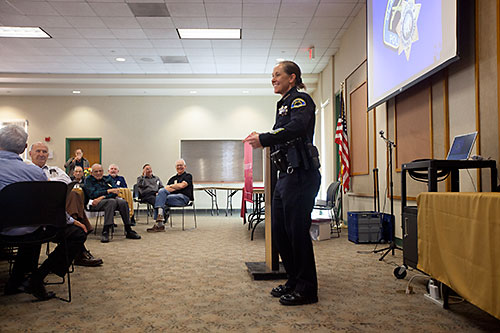Police body cameras would be useful, but expensive to implement

The pros and cons of police body cameras were discussed by Claremont Police Chief Shelly Vander Veen Tuesday.
The chief was the guest speaker during the University Club of Claremont luncheon at the Hughes Center. The topic was how technology has changed policing over the years, but body cameras dominated the talk.
The technology, in which an officer wears a tiny camera on their lapel, sunglasses or chest and records daily interactions, is not new to Claremont or to police departments in general. Chief Vander Veen said the fatal shooting of Michael Brown in Ferguson, Missouri in 2014—and the ensuing controversy regarding what exactly happened that day between Mr. Brown and Officer Darren Wilson—”brought to light th
There are numerous benefits to having a body-worn camera out in the field, the chief said, including documenting evidence, officer training, preventing or resolving complaints and exonerating officers from bogus complaints lodged against them.
Chief Vander Veen cited a study by the Rialto Police Department on body-worn cameras that revealed a noticeable drop in officer-involved incidents. Rialto saw a 60 percent reduction in use of force by officers, as well as an 88 percent reduction in the number of citizen complaints.
The chief noted she would like to see the actual numbers involved to see how many incidents were logged in the first place, but, “nonetheless, they had significant positive response to the body-worn camera system.”
Chief Vander Veen noted in her talk that the CPD has been testing out the feasibility of body-worn cameras since 2014, and were left with two main concerns: battery life that would last as long as an officer’s 12-hour shift, and privacy.
If implemented, the chief was confident that Claremont officers would not be opposed to wearing them.
“When we transition to body-worn cameras, other than making sure the policies are appropriate, I don’t think our officers will have any complaints,” she said. “They’re not opposed to it because it has helped out our officers more than it would ever hamper the work that they’re doing.”
Privacy was a main drawback in the chief’s talk, as she offered hypothetical situations of body-worn cameras getting in the way of a victim’s right to privacy. Crime victims who had a right to privacy, she said, would have to be entitled to efforts to keep that privacy, such as redaction and
“How would you feel if you know an officer walks into your house and they’re recording everything in your house,” the chief said. “How would that make you feel on the other end of the body-worn camera?”
But technology is improving, and the chief noted that some body camera programs contain facial recognition software that identifies the victim and blurs out their face throughout the video.
Beyond that is the question of what is and isn’t part of the public record. Chief Vander Veen wondered if the camera footage would be available for public use, using TMZ as an example of a media outlet with less than altruistic intentions.
“If it’s public record, all TMZ has to do is request all this video, and we just made their reality television program,” she said.
The implementation of body-worn cameras would also face financial difficulties, the chief said. A study done by the department noted the total amount or data collected by body-worn cameras would hover around 32 terabytes, a massive amount of data with a six-figure cost to properly store. Over what period of time?
“For 39 sworn officers in Claremont, the cost to implement the program like this would cost approximately $150,000 to get it started,” Chief Vander Veen said. “And that’s why we don’t have a camera system at the moment.”
Grants could be sought, but the chief noted that the grants would only pay for the cost of the cameras, as opposed to the storage.
The CPD could also get grants if they needed to address certain problem areas in the city, such as formal complaints or domestic violence, two situations where a body camera could be a useful tool. Claremont doesn’t have a significant problem in those areas, the chief said.
“We are keeping our eye out for grants, but there are some difficulties in obtaining some of that money,” she said.
There is no timetable available for implementation of body cameras, but Chief Vander Veen told the COURIER that if they were to start now, it wouldn’t take long to start using them. She noted that she would prefer to use WatchGuard, the same company the CPD uses for dashboard cameras in police cruisers, to make it easier for officers to learn the program.
“We could easily implement it within six months,” she said.
—Matthew Bramlett
news@claremont-courier.com









0 Comments